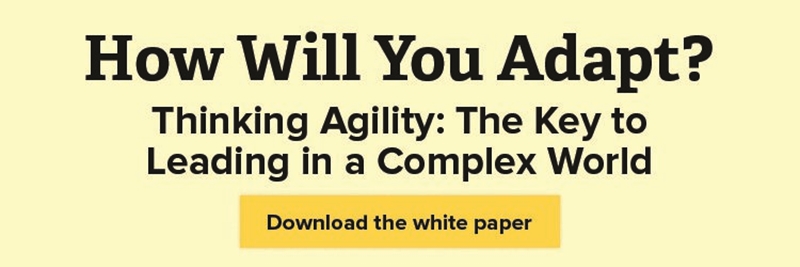Volatility. Uncertainty. Complexity. Ambiguity. You’d be hard-pressed to find a better description of today’s business environment than these four words.
The US Army War College coined the acronym VUCA to paint a picture of the world that emerged from the end of the Cold War. What makes this VUCA world particularly challenging is the fact that our education and training doesn’t prepare us for it. We’ve been taught to focus on our strengths and get really great at that one special thing we do. But extreme specialisation doesn’t cut it any more.
So we’re left with some troubling questions: Are business leaders, managers and employees nimble enough to keep up? Do they have the agile thinking skills to execute on what has to get done today, see around corners to anticipate change, make meaning of a plethora of data and manage a wide variety of relationships?
Our research shows that CEOs do tend to have it – agile thinking has always been part of their job. But now it’s part of everyone’s job.
Many leaders, managers and employees struggle to take advantage of the diversity of thought available to them, even in the best of circumstances. The circumstances are now exponentially tougher.
Thinking agility is all about the ability to consciously shift your thinking when the situation requires it. The good news is, it can provide the antidote to an increasingly volatile, uncertain, complex and ambiguous world.
What are the benefits of thinking agility?
“When designing and implementing responses to business issues and challenges, the human brain functions at its most innovative, productive best only when all four quadrants [of thinking preferences as depicted in the Whole Brain® Model] engage situationally and iteratively in the process.” Ned Herrmann
Whether you need people to be more agile, think more creatively or stretch to new and different skills, the “heavy-lifting” you’re asking them to do comes from the brain. And as the day-to-day mental demands of the workplace grow more challenging – from juggling priorities and tasks to solving complex problems and navigating constant change – the ability to access and apply the best thinking for the situation becomes that much more important.
You, your employees and every one of us have mental filters that are our thinking comfort zones, influencing the way we view the world. These filters inform how we communicate, behave, respond to others and what we pay attention to. They also create the go-to approach we rely on when tackling a problem, project or task – regardless of whether or not it’s the best approach for the job.
But we’re not limited by those filters. Just like cross training in the gym helps you build up your underdeveloped muscles, cross training for the brain will help your employees get more comfortable with their less-preferred mental muscles.
As a result, they’ll become more open to different perspectives and more mentally fit to deal with the challenges of today’s work environment. Flexibility, endurance, speed, balance, agility – all those same terms you use to describe the benefits of a physical cross-training regimen apply here, too.
We often refer to this as being situational: rather than defaulting to the same approaches regardless of the mental demands of the task or problem, the employee has an entire thinking toolkit to pull from. And that situational capability will automatically open the door to more creative, breakthrough thinking.
How can you train your organisation to be agile thinkers?
Okay, you’re sold. So how do you begin strengthening the brainpower in your organisation? Here are a few starting points:
Make thinking top of mind: Our mental defaults work so well that we’re typically not consciously aware of them. That’s why the first step in increasing thinking agility involves meta-cognition – thinking about thinking. A validated assessment like the HBDI® can help employees identify their thinking defaults as well as the kinds of thinking they avoid, how their thinking contributes to and detracts from their success, and where to focus their development to increase their situational wholeness.
Prepare their brains for the challenge: Overexert or fail to adequately warm up before your workout, and you can end up with an injury. Ask people to stretch to new skills or think in new ways without giving them the right tools and support, and you can end up with a team that’s frustrated, burned-out and demotivated. Start by understanding your employees and the mental demands of their jobs, and make sure employee training programmes are designed to engage their brains and provide that all-important context for learning.
Provide opportunities to exercise different thinking muscles: Regular practice not only builds up mental muscles, it also establishes and reinforces a more whole-brained approach to work. There are a number of tools and models you can provide to make it easy for people to remember to stretch outside their comfort zones. The Whole Brain® Business Book, Second Edition also includes a seven-day programme for exercising all four thinking quadrants.
Assemble “diverse by design” teams: In today’s environment, everyone needs to be able to draw on all the thinking that’s available – and that includes the thinking of co-workers, direct reports, leaders and others. Especially when you’re dealing with complex problems or projects, a mentally diverse team that is encouraged to listen to, respect and apply all of the cognitive resources it has will outperform all the others.
Whether as part of a fitness regimen or an employee training program, cross training helps people push the boundaries on their previous limits and get a fresh perspective on where they are and where they can go. Make sure your programme includes the most important tool available: the brain.


